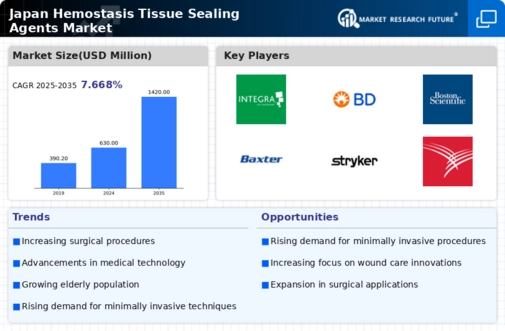Rising Surgical Procedures
The increasing number of surgical procedures in Japan is a primary driver for the hemostasis tissue-sealing-agents market. As the population ages, the demand for surgical interventions, including orthopedic, cardiovascular, and general surgeries, escalates. In 2025, it is estimated that surgical procedures will rise by approximately 5% annually, leading to a heightened need for effective hemostatic agents. These agents are crucial in minimizing blood loss and ensuring patient safety during operations. The growing emphasis on minimally invasive techniques further propels the demand for advanced sealing agents, as they facilitate quicker recovery times and reduced hospital stays. Consequently, the hemostasis tissue-sealing-agents market is poised for substantial growth, driven by the increasing volume of surgical interventions across various medical specialties.
Increased Focus on Patient Safety
The growing emphasis on patient safety in surgical settings is a significant driver for the hemostasis tissue-sealing-agents market. Healthcare institutions in Japan are prioritizing the reduction of surgical complications, including excessive bleeding, which can lead to adverse outcomes. As a result, there is a heightened demand for reliable hemostatic agents that can effectively control bleeding during procedures. In 2025, it is anticipated that hospitals will allocate approximately 15% of their surgical budgets to advanced hemostatic solutions. This trend underscores the importance of investing in high-quality sealing agents that enhance patient safety and improve surgical results. Consequently, the hemostasis tissue-sealing-agents market is expected to benefit from this increased focus, as healthcare providers seek to adopt products that align with their commitment to delivering optimal patient care.
Technological Innovations in Hemostasis
Technological advancements in hemostasis tissue-sealing agents are significantly influencing the market landscape in Japan. Innovations such as bioactive materials and advanced polymer technologies enhance the efficacy and safety of these agents. For instance, the introduction of fibrin sealants and synthetic adhesives has improved hemostatic performance, leading to better patient outcomes. The market is projected to grow at a CAGR of around 6% from 2025 to 2030, driven by these innovations. Furthermore, the integration of smart technologies, such as real-time monitoring systems, is expected to revolutionize surgical practices, making hemostatic agents more effective. As healthcare providers increasingly adopt these cutting-edge solutions, the hemostasis tissue-sealing-agents market is likely to experience robust expansion, reflecting the ongoing commitment to improving surgical techniques and patient care.
Growing Awareness of Advanced Wound Care
The rising awareness of advanced wound care solutions is contributing to the growth of the hemostasis tissue-sealing-agents market in Japan. As healthcare professionals and patients become more informed about the benefits of effective hemostatic agents, the demand for these products is likely to increase. Educational initiatives and training programs aimed at promoting the use of advanced sealing agents are gaining traction, leading to a more informed healthcare workforce. In 2025, it is estimated that the market for advanced wound care products will grow by 7%, further driving the adoption of hemostatic agents. This trend indicates a shift towards more sophisticated wound management practices, which will likely enhance the overall market for hemostasis tissue-sealing agents.
Regulatory Support for Innovative Products
Regulatory support for innovative medical products is a crucial driver for the hemostasis tissue-sealing-agents market. In Japan, the Pharmaceuticals and Medical Devices Agency (PMDA) has streamlined the approval process for new hemostatic agents, encouraging manufacturers to invest in research and development. This supportive regulatory environment fosters innovation, allowing for the introduction of novel products that meet the evolving needs of healthcare providers. As a result, the market is expected to witness a surge in new product launches, with an anticipated growth rate of 5% annually over the next five years. This trend not only enhances competition among manufacturers but also provides healthcare professionals with a broader range of effective hemostatic solutions, ultimately benefiting the hemostasis tissue-sealing-agents market.



















Leave a Comment